
How to Use Logic Level Converter 8-channel Bi-directional: Examples, Pinouts, and Specs
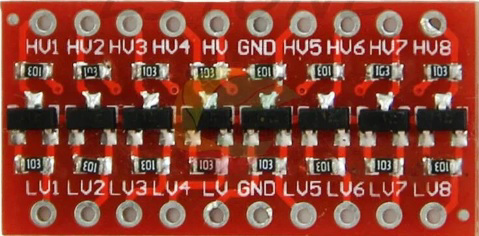
 Design with Logic Level Converter 8-channel Bi-directional in Cirkit Designer
Design with Logic Level Converter 8-channel Bi-directional in Cirkit DesignerIntroduction
The Logic Level Converter 8-channel Bi-directional is a versatile electronic component designed to facilitate communication between devices operating at different voltage levels. It enables seamless and safe bi-directional data transfer across 8 independent channels, making it an essential tool for interfacing low-voltage microcontrollers (e.g., 3.3V) with higher-voltage peripherals (e.g., 5V).
Explore Projects Built with Logic Level Converter 8-channel Bi-directional
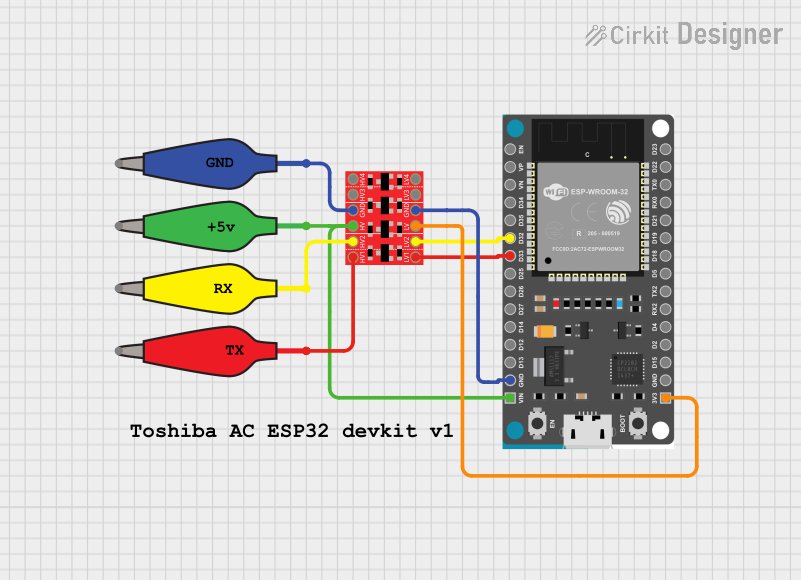
 Open Project in Cirkit Designer
Open Project in Cirkit Designer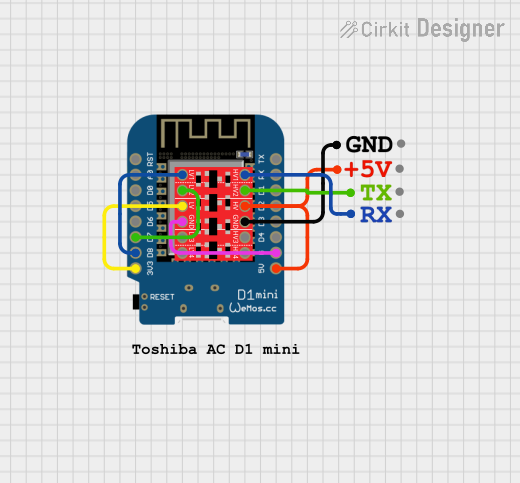
 Open Project in Cirkit Designer
Open Project in Cirkit Designer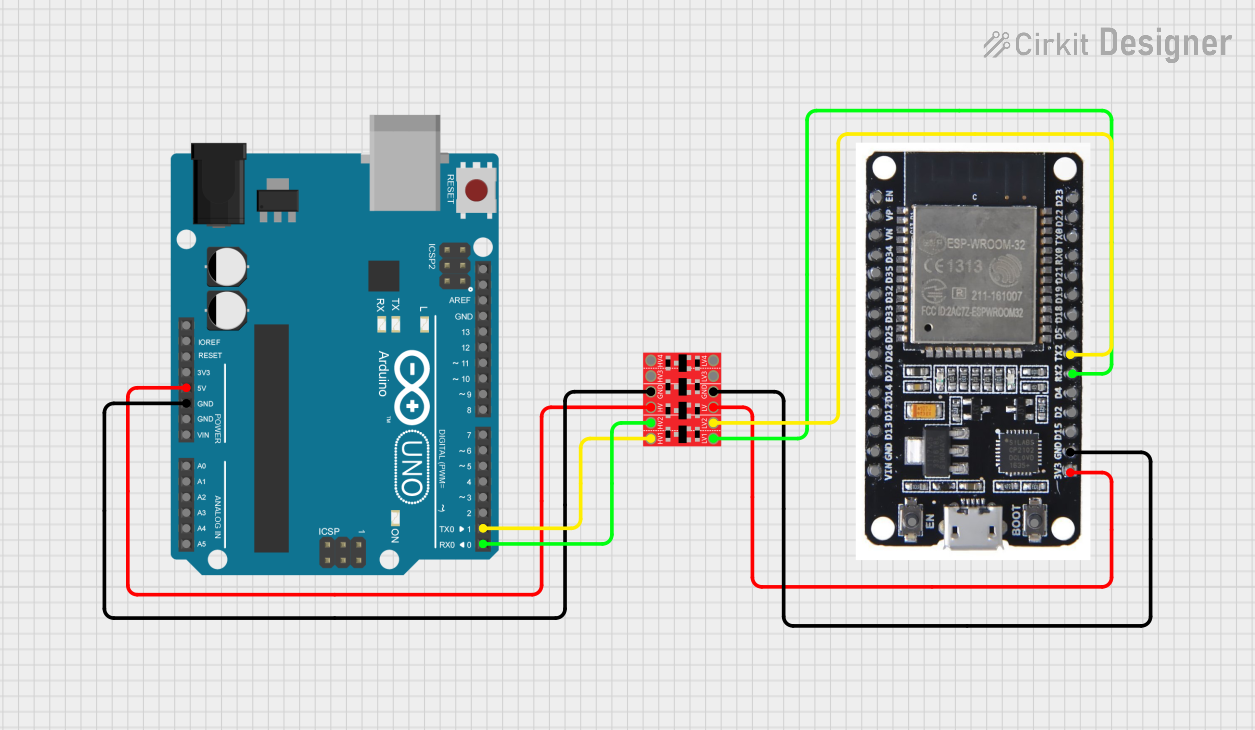
 Open Project in Cirkit Designer
Open Project in Cirkit Designer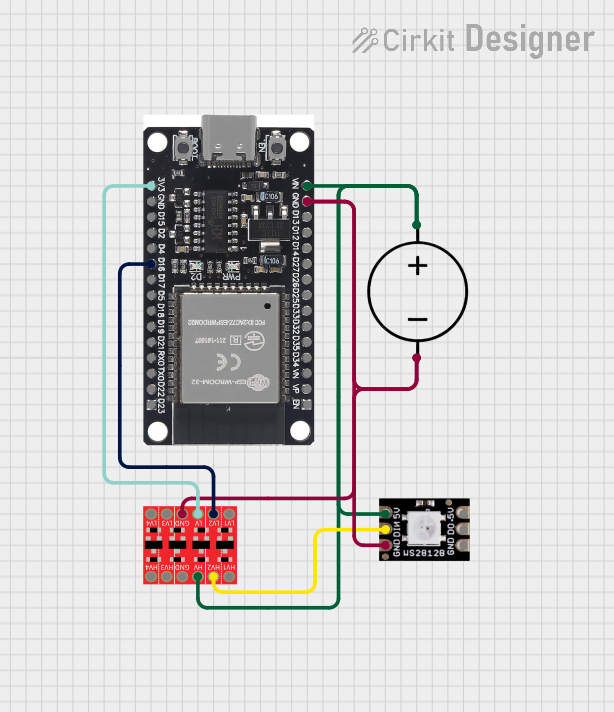
 Open Project in Cirkit Designer
Open Project in Cirkit DesignerExplore Projects Built with Logic Level Converter 8-channel Bi-directional

 Open Project in Cirkit Designer
Open Project in Cirkit Designer
 Open Project in Cirkit Designer
Open Project in Cirkit Designer
 Open Project in Cirkit Designer
Open Project in Cirkit Designer
 Open Project in Cirkit Designer
Open Project in Cirkit DesignerCommon Applications and Use Cases
- Interfacing 3.3V microcontrollers (e.g., Arduino, Raspberry Pi) with 5V sensors or modules.
- Communication between 1.8V, 3.3V, and 5V devices in mixed-voltage systems.
- Level shifting for I2C, SPI, UART, and other digital communication protocols.
- Prototyping and testing circuits with varying voltage requirements.
Technical Specifications
The following table outlines the key technical details of the Logic Level Converter 8-channel Bi-directional:
| Parameter | Specification |
|---|---|
| Operating Voltage (High Side) | 3.3V to 5.5V |
| Operating Voltage (Low Side) | 1.8V to 3.3V |
| Number of Channels | 8 Bi-directional |
| Communication Protocols Supported | I2C, SPI, UART, GPIO, etc. |
| Maximum Data Rate | Up to 100 kHz (I2C) or higher for GPIO |
| Dimensions | ~36mm x 20mm x 5mm |
Pin Configuration and Descriptions
The Logic Level Converter has the following pin layout:
| Pin Name | Description |
|---|---|
| HV | High voltage input (connect to the higher voltage, e.g., 5V). |
| LV | Low voltage input (connect to the lower voltage, e.g., 3.3V). |
| GND | Ground (common ground for both high and low voltage sides). |
| TX1-TX8 | High voltage side data pins (connect to the high-voltage device). |
| RX1-RX8 | Low voltage side data pins (connect to the low-voltage device). |
Usage Instructions
How to Use the Component in a Circuit
Power Connections:
- Connect the
HVpin to the high voltage supply (e.g., 5V). - Connect the
LVpin to the low voltage supply (e.g., 3.3V). - Connect the
GNDpin to the common ground of both voltage domains.
- Connect the
Data Connections:
- For each channel, connect the high-voltage device's data line to the corresponding
TXpin. - Connect the low-voltage device's data line to the corresponding
RXpin. - Repeat for all channels as needed.
- For each channel, connect the high-voltage device's data line to the corresponding
Communication Protocols:
- The converter supports I2C, SPI, UART, and GPIO. Ensure proper pull-up resistors are used for I2C communication.
Important Considerations and Best Practices
- Voltage Compatibility: Ensure the
HVandLVvoltages are within the specified ranges. - Pull-up Resistors: For I2C communication, use appropriate pull-up resistors on both the high and low voltage sides.
- Channel Usage: Unused channels can be left unconnected.
- Power Supply: Use a stable power supply to avoid communication errors.
Example: Connecting to an Arduino UNO
Below is an example of using the Logic Level Converter to interface a 3.3V sensor with a 5V Arduino UNO via I2C:
Circuit Connections
- Connect the Arduino's
5Vpin to theHVpin of the converter. - Connect the Arduino's
GNDpin to theGNDpin of the converter. - Connect the sensor's
3.3Vpin to theLVpin of the converter. - Connect the sensor's
GNDpin to theGNDpin of the converter. - Connect the Arduino's
SCLandSDApins toTX1andTX2, respectively. - Connect the sensor's
SCLandSDApins toRX1andRX2, respectively.
Arduino Code Example
#include <Wire.h> // Include the Wire library for I2C communication
void setup() {
Wire.begin(); // Initialize I2C communication
Serial.begin(9600); // Start serial communication for debugging
Serial.println("I2C Communication Initialized");
}
void loop() {
Wire.beginTransmission(0x40); // Start communication with the sensor at address 0x40
Wire.write(0x00); // Send a command or register address to the sensor
Wire.endTransmission(); // End the transmission
Wire.requestFrom(0x40, 2); // Request 2 bytes of data from the sensor
if (Wire.available() == 2) { // Check if 2 bytes are available
int data = Wire.read() << 8 | Wire.read(); // Read and combine the 2 bytes
Serial.print("Sensor Data: ");
Serial.println(data); // Print the sensor data
}
delay(1000); // Wait for 1 second before the next reading
}
Troubleshooting and FAQs
Common Issues and Solutions
No Communication Between Devices:
- Verify that the
HVandLVpins are connected to the correct voltage levels. - Ensure the
GNDpin is connected to the common ground of both devices. - Check for loose or incorrect wiring.
- Verify that the
Data Corruption or Noise:
- Use shorter wires to reduce noise and signal degradation.
- Add pull-up resistors for I2C communication if not already present.
One Side Not Responding:
- Confirm that the devices on both sides are powered and operational.
- Double-check the connections to the
TXandRXpins.
FAQs
Q1: Can I use this converter for analog signals?
A1: No, the Logic Level Converter is designed for digital signals only. It cannot be used for analog signal conversion.
Q2: What is the maximum data rate supported?
A2: The maximum data rate depends on the protocol and voltage levels. For I2C, it typically supports up to 100 kHz, but it may handle higher speeds for GPIO.
Q3: Do I need external pull-up resistors for I2C?
A3: Yes, external pull-up resistors are required for proper I2C communication. Use appropriate resistor values for the voltage levels in your circuit.
Q4: Can I use fewer than 8 channels?
A4: Yes, you can use as many or as few channels as needed. Unused channels can be left unconnected.